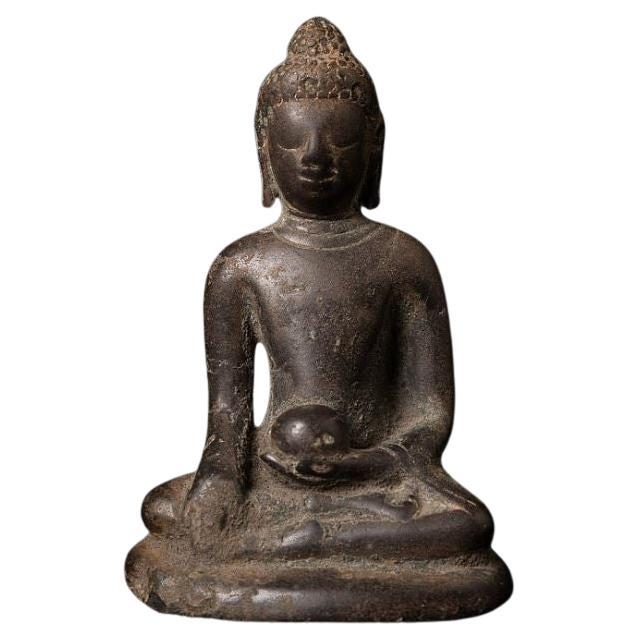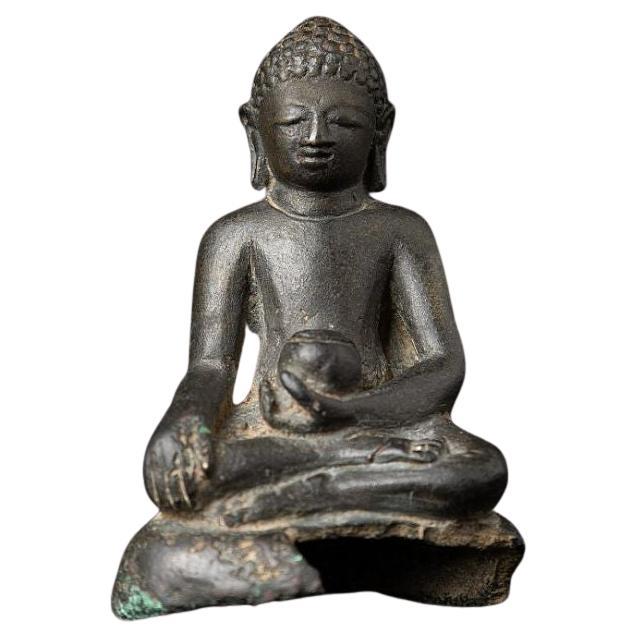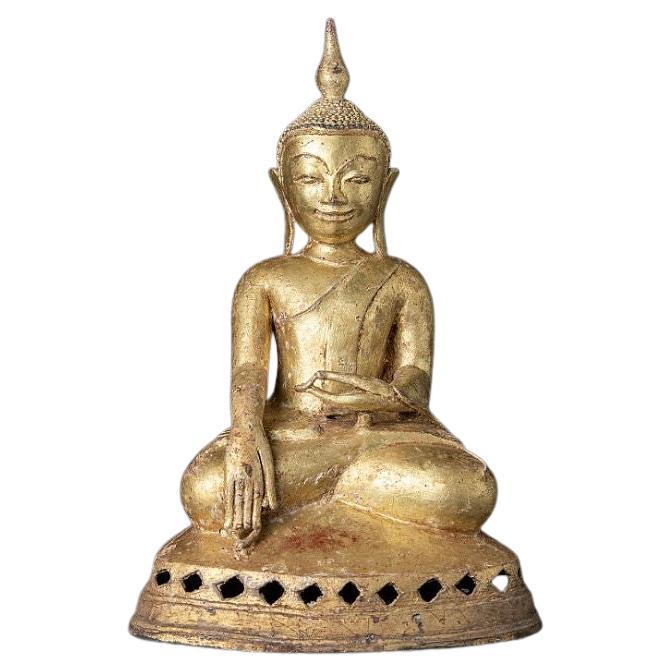Items Similar to Special Antique Bronze Pyu Buddha from Burma
Video Loading
Want more images or videos?
Request additional images or videos from the seller
1 of 10
Special Antique Bronze Pyu Buddha from Burma
About the Item
Material: bronze
Measures: 19 cm high
Weight: 1.45 kgs
Pyu style
Bhumisparsha mudra
Originating from Burma
8th century
With few traces of 24 krt. gilding
With a very nice and beautiful, original patina !
Very small crack in the neck of the statue, but the statue is still very strong. Can be restored upon request.
Found in Beikthano area, one of the 3 most powerful ancient Pyu cities in Burma.
- Dimensions:Height: 7.49 in (19 cm)Width: 5.71 in (14.5 cm)Depth: 3.75 in (9.5 cm)
- Materials and Techniques:
- Place of Origin:
- Period:
- Date of Manufacture:8th Century
- Condition:Wear consistent with age and use.
- Seller Location:DEVENTER, NL
- Reference Number:
About the Seller
5.0
Gold Seller
These expertly vetted sellers are highly rated and consistently exceed customer expectations.
Established in 1997
1stDibs seller since 2022
20 sales on 1stDibs
Typical response time: 9 hours
- ShippingRetrieving quote...Ships From: DEVENTER, Netherlands
- Return PolicyA return for this item may be initiated within 14 days of delivery.
More From This SellerView All
- Special antique bronze Burmese Pyu Buddha from BurmaLocated in DEVENTER, NLMaterial: bronze 10,8 cm high 7,5 cm wide and 5 cm deep Weight: 0.563 kgs Pyu style Bhumisparsha mudra Originating from Burma 7-9th century - original from the Pyu period Ve...Category
Antique 15th Century and Earlier Burmese Sculptures and Carvings
MaterialsBronze
- Special Antique Bronze Pyu Buddha Statue from BurmaLocated in DEVENTER, NLMaterial: bronze 9,4 cm high 6,2 cm wide and 4,1 cm deep Weight: 0.405 kgs Pyu style Bhumisparsha mudra Originating from Burma 7-10th century - original from the Pyu period ...Category
Antique 15th Century and Earlier Burmese Sculptures and Carvings
MaterialsBronze
- Very Special Bronze Pyu Buddha Statue from BurmaLocated in DEVENTER, NLMaterial: bronze 19 cm high 12,8 cm wide and 5 cm deep Pyu style Bhumisparsha mudra Originating from Burma 6 - 9th century / original from the Pyu period This is the most special Pyu Buddha...Category
Antique 15th Century and Earlier Burmese Sculptures and Carvings
MaterialsBronze
- Special Antique Bronze Burmese Buddha Statue from BurmaLocated in DEVENTER, NLMaterial: bronze 48,5 cm high 22 cm wide and 15,5 cm deep Weight: 5.632 kgs With light traces of 24 krt. gilding Ava style Varada mudra Originating from Burma 16th Century ...Category
Antique 16th Century Burmese Sculptures and Carvings
MaterialsBronze
- Special Antique Bronze Burmese Buddha Statue from BurmaLocated in DEVENTER, NLMaterial: bronze 35,3 cm high 23,2 cm wide and 16,9 cm deep Weight: 4.939 kgs Gilded with 24 krt. gold Ava style Bhumisparsha mudra Originating from Burma 15th Century Very...Category
Antique 15th Century and Earlier Burmese Sculptures and Carvings
MaterialsBronze
- 6th - 8th Century Special Bronze Pyu Buddha Statue from Burma Original BuddhasLocated in DEVENTER, NLThis antique bronze Buddha statue is a truly unique and special collectible piece. Standing at 20 cm high, 13 cm wide and 7 cm deep, it is made of bronze and it is in the Pyu style, depicting the Bhumisparsha mudra. This statue is believed to originate from Burma and dates back to the 6-8th century, making it an original piece from the period. The statue is very rare, and it is the largest Pyu Buddha that the owner of the collection ever had. The statue has a beautiful patina, adding to its beauty and value. This statue is a must-have for any collector of antique Asian art, particularly those who specialize in Burmese art...Category
Antique 15th Century and Earlier Burmese Sculptures and Carvings
MaterialsBronze
You May Also Like
- Large Burmese Bronze Medicine Buddha, Pagan Style, Late 19th CenturyLocated in Austin, TXA large and magnificent cast bronze image of the Medicine Buddha, Bhaisajyaguru, rendered in the Burmese Pagan style, and most likely based on a period example that was either damaged or lost, 19th century, Burma or Thailand. He can be identified as the Medicine Buddha by the hand that rests in his lap, with his middle finger touching the thumb. A medicine pot or fruit stem would originally have been placed in his upturned palm. The face of this Buddha has been sculpted masterfully. He has a beautiful heart shaped face topped by hair neatly arranged in the typical "snail shell curls", and surmounted by a high ushnisha. Long, pendulous earlobes frame his face, a symbol of his princely past. He gazes serenely outwards from heavily lidded, downcast eyes, a content smile upon his full, lush lips. The Buddha is portrayed seated in vajrasana (full lotus position), his elegant hands displayed in varada mudra, the gesture of granting favors and fulfilling wishes. Long, exquisite fingers extended, the thumb and middle finger touching in a gesture of compassion. He is clothed in a simple kasaya wrapped around his body and over one shoulder, leaving the shoulder and part of his chest bare. The diaphanous garment clings to his body, outlining his well proportioned and graceful, almost sensuous, form. The excess material pooled in neat pleats in front of him. A sash thrown over his shoulder. He sits upon a double lotus base upon a raised platform. The platform features two kneeling attendants, usually interpreted as the monks Ananda and Kasyapa. Between them is a circular disc representing the Wheel of Dharma. Contained in the disk is a flower with eight petals, symbolizing the eightfold path, one of the principle teachings of the Buddha. The sides and back of the platform featuring a series of singha, or lions, representative of the Buddha's royal past. An applied lacquer patina covers the entirety of the image. Large deposits of ash (from incense) are present between the curls of the hair, as well as some the other crevices, indicating this image was the subject of worship for many years. Bhaisajyaguru, also called the Medicine Buddha, or Buddha of Healing, is a revered figure in the Buddhist pantheon as a master able to cure suffering, both physical and spiritual, through his teachings. The Pagan Empire ruled most of present day Burma (Myanmar) from 849 to 1297. The capital, Bagan, served as a both the center of government and religion, where Buddhism reigned supreme. Bagan was also at a crossroads of the Buddhist world, with influence from India, Nepal, Tibet, China, and even Indonesia shaping their culture. As such, Pagan Buddha...Category
Antique Late 19th Century Burmese Sculptures and Carvings
MaterialsBronze
- Large Pair of Antique Style Bronze Thai Praying BuddhasLocated in Stamford, CTLarge pair of antique style bronze Thai kneeling and praying Buddhas. Intricate detail, gilt head piece. Probably mid 20th century.Category
Mid-20th Century Thai Sculptures and Carvings
MaterialsBronze
- Burmese Mandalay Style Gilt Lacquered Buddha & Red Lacquer Covered Baluster VaseLocated in Ottawa, OntarioA Burmese Mandalay style gilt lacquered wood standing figure of Buddha and together with an unusual Burmese red lacquer covered baluster offering vas...Category
20th Century Burmese Chinese Export Sculptures and Carvings
MaterialsWood, Lacquer
- Large Bronze Buddha Head with Stand ThailandLocated in Atlanta, GAA impressive bronze Buddha head fragment displayed on wood stand circa late 19th century. The Buddha was cast in the early "U Thong" style that flourished between the 12-13rd century A.D in Central Thailand. The Buddha iconography of that period is exemplified by the influence from Mon and Khmer kingdom, featuring a more square face and a characteristic small band between the hairline and the forehead. This large Buddha head...Category
Antique 19th Century Thai Other Sculptures and Carvings
MaterialsBronze
- 19th Century Gold Gilded Bronze BuddhaLocated in Vero Beach, FL19th century gold gilded bronze Buddha A finely cast bronze Buddha statue in gold gilt with modeled and incised floral motifs. This jeweled God o...Category
Antique 19th Century Chinese Qing Sculptures and Carvings
MaterialsBronze
- Japanese Antique Wood Carving Buddha 1700s-1800s / Figurine Object Wabi SabiLocated in Sammu-shi, ChibaThis is a very old Japanese wooden Buddha. It is a wood carving from the Edo period (1700s-1800s). It appears to be carved out of cedar wood. It is indescribably beautiful with dust...Category
Antique Late 18th Century Japanese Edo Sculptures and Carvings
MaterialsCedar
Recently Viewed
View AllMore Ways To Browse
Small Antique Bronze
15th Bronze
15th Century Bronze
Ancient Asian Antiques
The Bronze Buddha
Small Bronze Sculpture Antique
Sculpture Bronze 19
Buddha Patina
Small Bronze Statues
Special Buddha
Century Small Buddha
Small Buddha
19 Century Antique Sculpture
Antique Small Bronze Statues
Ancient Buddha
Small Antique Statue
15th Buddha
Century 19 Statue





